Created by Sporcle
Check out their website for more fascinating quizzes
Follow them on Twitter @sporcle
Like O-Posts on Facebook
You can also follow O-Posts on Twitter @OPosts

It was the 26th August last year when Liverpool completed the signing of Mario Balotelli, turning to the Italian after missing out on Alexis Sanchez and deciding not to gamble on Loic Remy’s heart concerns. With deadline day looming and Luis Suarez having departed the month before, it was a choice between Balotelli and Samuel Eto’o to replace the Uruguayan.
Brendan Rodgers and Liverpool’s transfer committee decided on the former and eleven months later, with Balotelli in limbo and Lazio and Sampdoria being linked, it was a move they got emphatically wrong. But with Eto’o now at the newly rich Turkish club Antalyaspor after a short spell with Sampdoria via Everton, it is now looking in retrospect exactly like the type of decision Rodgers and his committee won’t want to have to make again.
Hence why this time around they have already met to ratify six signings before the month of August has even begun, with Roberto Firminho, Danny Ings, James Milner, Adam Bogdan, Nathaniel Clyne and Joe Gomez through the door.
A seventh signing has all-but been secured, with Christian Benteke due to complete a £32.5 million move from Aston Villa should he pass a medical. That will take Liverpool’s summer spending past £70 million, short of the £117m that was outlaid last year but this time the business has been sharp and level-headed, with Rodgers, now under pressure to deliver an upturn in performance after May’s meeting with club owners FSG, desperate to avoid a repeat of last August’s scattergun finale.
Benteke’s arrival, sparked by Liverpool’s agreement to meet his release clause with haste after hearing that Manchester United may have been interested, is likely to spell the end for Rickie Lambert just as much as Balotelli. Lambert started just 7 times for Liverpool last season after a £4 million move from Southampton and having only managed two goals, he will be behind Benteke and Divock Origi, who will return from a loan spell at Lille. With West Brom interested, the England forward has been told he is allowed to leave.
The 20 year old Origi found the net just 9 times in 44 games in France last term but Rodgers saw enough in the Belgian to fork out £10 million for him last July so he is likely to be entrusted to serve as Benteke’s understudy as his 24 year old countryman plays the central attacking role in a 4-3-3.
Raheem Sterling’s exit to Manchester City, for the £40 million that has helped to fund the move for Benteke, will mean that Brazilian duo of Firmino, who joins with the sizeable price tag of £29 million from Hoffenheim, and Phillipe Coutinho, aiming to build on an impressive season at Anfield, will play either side of the central attacker.
Ings, Lazar Markovic, Jordan Ibe, Adam Lallana and Daniel Sturridge, who Rodgers will be longing to get fit after a 12 months of chronic injury trouble, will provide the manager with variety should he feel the need to freshen his team up.
Rodgers was lauded for his ability to change and alter systems when he navigated the 2013/14 vintage to within two points of the title but last season, hindered by the exit of Suarez, the absence of Sturridge and the disruption of Sterling later on in the campaign, he simply wasn’t able to replicate that versatility and Liverpool often looked laboured and predictable when going forward.
Robbed of an attacking focal point with Balotelli typically disinterested and Lambert struggling to stake a claim, Sterling was often trusted with a central role and so followed a Liverpool that appeared anaemic in front of goal; scoring a total of 52 goals, the least in the top 7 and down from 101 the season before.
Benteke, who arrives with a record of 42 goals in 88 games from his time with Aston Villa, will play a huge role in solving that problem. Liverpool will be aware of that first-hand having witnessed the Belgian score 5 goals in his last 6 outings against the Merseyside club.
Given the provision of the likes of Coutinho, Firmino, Lallana and Ings, with Alberto Moreno and Clyne being urged forward from deep, Benteke should thrive among a higher calibre of player than those he found himself surrounded by at Villa.
There should be no repeat of the lethargy that existed under Paul Lambert that caused Benteke to go 13 games without a goal as Villa sank agonisingly close to relegation, Rodgers’s adventurous style bears more similarities to that of Tim Sherwood who managed to get the Belgian firing with 11 goals in his last 9 games to keep the Midlands club up.
Of course that service will require some compromise and an admittance from Rodgers that a short, intricate passing approach may not always be the best route to incision. Liverpool made the least crosses from open play last season (409) and that will be a concern given Benteke’s muscular 6ft 3 inch frame feeds off balls into the box.
“There’s no point going to a club where they don’t cross the ball”, said Sherwood ahead of the FA Cup final, possibly in a reference to his future employers.
There is a lot more to the Belgian than his ability in the air, though his record of 188 headers won was a league high for strikers last season and will undoubtedly offer Liverpool a direct option should they need to get the ball forward quickly. Benteke’s power and strength, partnered with his underrated control and touch, will then occupy defenders to create room for the multitude of other attackers in Liverpool’s armoury.
Comparisons will be made to Andy Carroll, to whom Benteke now becomes 2nd in line as the most expensive Liverpool player of all time and who Rodgers jettisoned as he assumed the reigns from Kenny Dalglish, but the 24 year old arrives with much greater pedigree and more facets to his play than the former Newcastle forward.
Carroll conjures caution around Anfield of how giant lumps of money can be wasted however, Rodgers has to ensure Benteke doesn’t follow or FSG’s leniency may quickly run out.
Written by Adam Gray
Follow Adam on Twitter @AdamGray1250
Like O-Posts on Facebook
You can also follow O-Posts on Twitter @OPosts
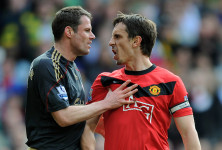
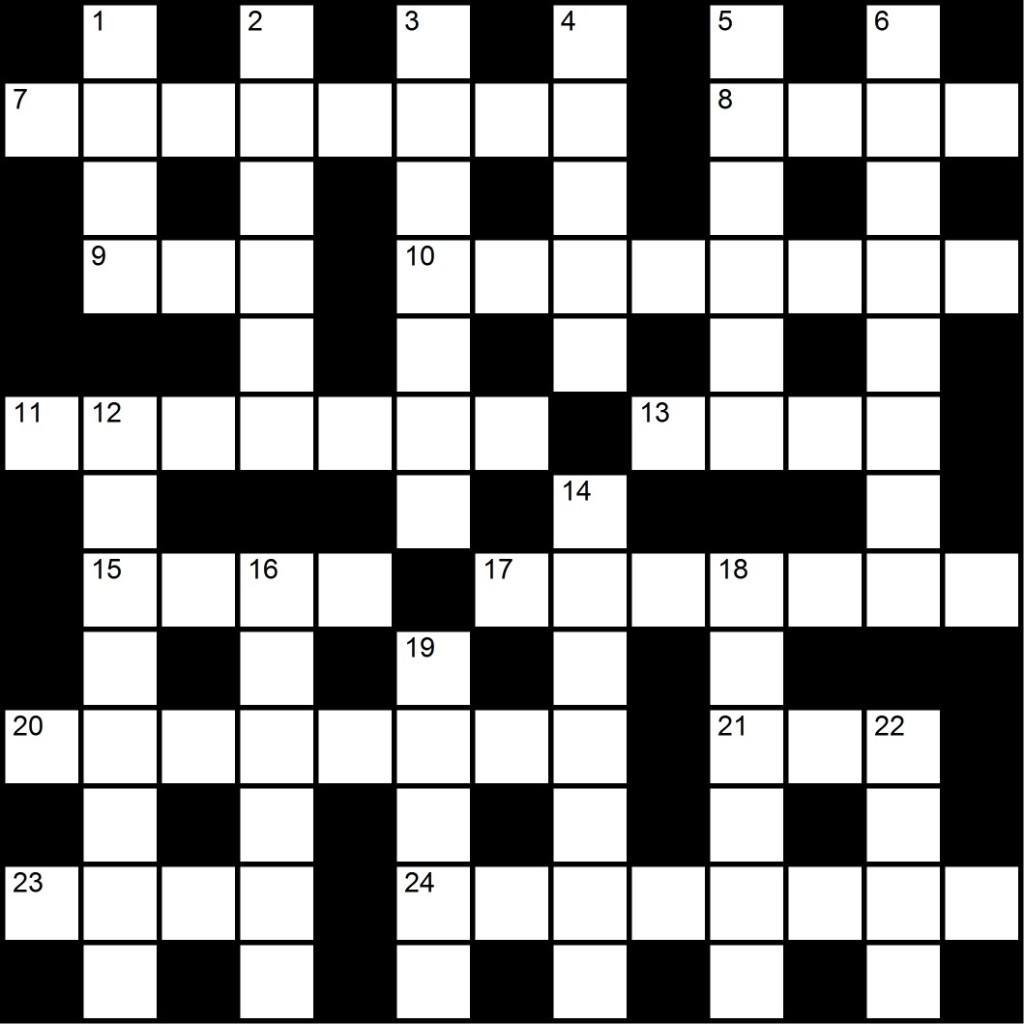
This week’s football puzzle sees bitter rivals Liverpool and Man United go head-to-head in our popular crossword face-off. So if you think you know your Phil Neals and your Phil Nevilles, come with us on another puzzle adventure!
Clues Across
7 United midfielder who went on to play for Inter then Liverpool (4,4)
8 Dejan Lovren and Milan Baros both had stints at this French club (4)
9 _ Macari, Man United star from the 1970s and 1980s (3)
10 Where Liverpool somehow came back from 3-0 down to win the Champions League in 2005 (8)
11 The Jimmy who defended for Northern Ireland and United (7)
13 Nickname of the club who sold Oyvind Leonhardsen and John Scales to Liverpool (4)
15 _ Litmanen, an underused talent during his brief spell at Anfield (4)
17 Mr Schweinsteiger, a new stellar signing for United (7)
20 ‘Old’ stadium dubbed the Theatre of Dreams (8)
21 & 4 down Shankly era colossus in defence - first Liverpool captain to lift the FA Cup (3,5)
23 Portuguese forward who signed for United in 2010 (4)
24 Domain of John Barnes and Ryan Giggs (4,4)
Clues Down
1 _ Meireles, tattooed midfielder who the Reds signed from Porto in 2010 (4)
2 A talented number seven (with a famous father) who Souness signed from Forest (6)
3 Stadium we connect with an 1980s Rap (7)
4 See 21 across
5 Spanish pass-master brought to Anfield by Rafa (6)
6 _ Moenchengladbach, the Reds beat them 3-1 in 1977 to win their first European Cup (8)
12 They blighted Daniel Sturridge’s game time last season (8)
14 Scene of United’s 2004 FA Cup Final triumph v Millwall and Liverpool’s 2006 FA Cup Final victory v West Ham (7)
16 Fabio Da Silva’s twin brother (6)
18 Long-ball specialities of Peter Schmeichel - launchpad for many a United attack (6)
19 FIFA _Player of the Year, award won by United’s Cristiano Ronaldo for 2008 (5)
22 Portugal winger who made a big money move to Old Trafford in 2007 (4)
Created by Aleric Linden
Check out more of his work at Puzzle-House through his website
Like O-Posts on Facebook
You can also follow O-Posts on Twitter @OPosts
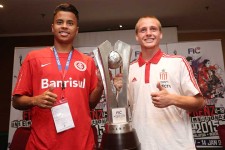
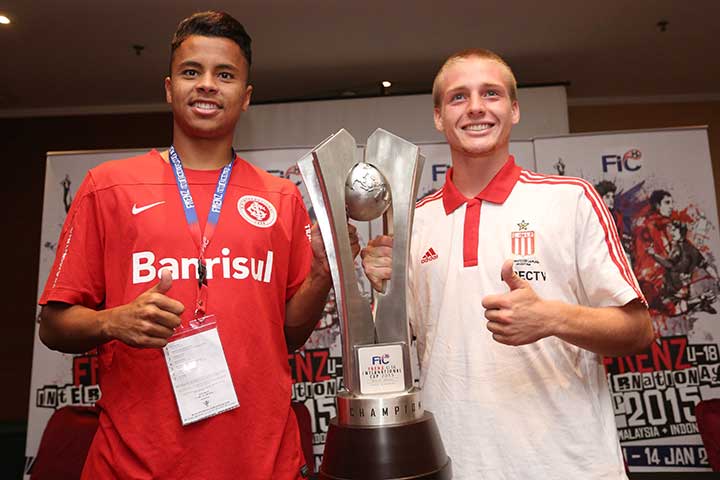
Allan (Left)
On the face of it, Liverpool FC’s participation in Malaysia’s Frenz International Cup earlier this year was not a resounding success. Their Under-18 side, proclaimed pre-tournament as ‘undoubtedly the team to beat’ by the competition website, won an easy group but were dumped out in the quarter final by Valencia.
However, as well as valuable experience for youth team players, these tournaments also provide a golden opportunity for clubs to uncover unknown stars in the making from around the world, and in this case Liverpool believe they have stumbled upon a diamond. A diamond in the shape of 18-year-old Allan Rodrigues de Souza, who starred in the Internacional side that swept all before them in South East Asia as they scored 20 goals in six games, culminating in a 3-2 final victory against Argentinian outfit Estudiantes.
From his role in central midfield, left-footed Allan scored two of those twenty. The first was a free kick curled into the top corner against Valencia, while the second was a magnificent 40-yard lob of the Porto goalkeeper in the semi final. The Scouse scouts in attendance are sure to have noted his technical excellence, precise long passing, strong tackling and ability to read the game.
Allan’s deliveries from corners and free kicks were also top notch (a fact that will inevitably lead eventually to his left foot being dubbed a wand in the English press), an area in which some observers believe Liverpool are currently lacking. He would most likely be employed at Anfield as a defensive midfielder or perhaps slightly further forward, spraying passes from the centre of the park, should formation allow.
As Inter have progressed to this year’s Copa Libertadores semi finals, boss Diego Aguirre has implemented a rotation policy in which the club’s youth teamers have seen plenty of first team action. Allan, however, is not among those to have been deemed ready and is yet to have made his professional debut. As such, Liverpool’s interest was a shock for Brazilian observers, most of whom had never heard of the youngster.
His youth, lack of experience and the potential difficulties of adapting to life in England make him a risky signing, however with an initial fee agreed upon of just £500,000, and further cash only due as a percentage of any future sale, the deal is a risk the Anfield club can easily afford to take.
Allan will, at least, have compatriots Lucas Leiva, Philippe Coutinho and fellow new boy Roberto Firmino to keep him company and help him settle in to life on Merseyside, although he will certainly not be joining them in the first team squad just yet.
Written by Calum Leahy
Follow Calum on Twitter @Calinho213
Follow the fantastic website that he’s a part of on everything Brazilian football on Twitter @Sambafoot_En
Check out Sambafoot’s website here
Like O-Posts on Facebook
You can also follow O-Posts on Twitter @OPosts
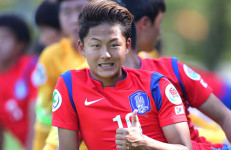
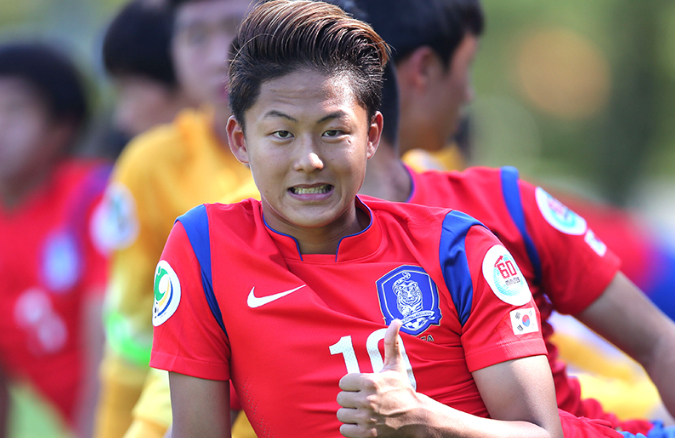
In early July, Lee Seung-Woo was promoted to Barcelona’s B-side, along with his compatriot Paik Seung-Ho.
Dubbed ‘The Korean Messi’, Lee has the footballing hopes of an entire nation on his shoulders, as they hope that he can grow up to be the world-class creative talent that Korea has so far struggled to produce.
Lee’s transfer to Barcelona in 2011 broke FIFA rules, and was one of the reasons behind Barcelona’s recent transfer embargo. Unfortunately for Lee, it has also meant that he is banned from playing competitively for Barcelona until his eighteenth birthday in January 2016.
He would however be able to play competitively if he were sold to a different club, leading to speculation in the past that he might join Liverpool, Chelsea, or even Barca’s biggest rivals Real Madrid, although a transfer now looks unlikely.
Despite not being able to play competitively for his club, he has been able to play for his country, representing them at various youth levels.
His most impressive performance was at the AFC Under-16 championships in Thailand where he scored five goals, including one where he dribbled the ball half the length of the pitch before scoring against Japan, and won player-of-the-tournament as South Korea reached the final where they lost to North Korea.
He made his debut for the Under-18’s in the Suwon JS Cup in May this year. However, he was unable to have as much of an impact at this level than he has at previous levels, and it was his Barcelona team-mate Paik Seung-Ho who impressed the critics with his passing ability instead.
Lee’s quiet performance suggests that he still has a long way to go before he is ready for the Barcelona first team, and his ban on playing competitively may slow down his progress.
But while some footballing prodigies such as Freddy Adu never quite make it at the highest level, footballing experts generally agree that Lee Seung-Woo has the potential to become a world-class player in the future.
Written by Steven Price
Check out more of his work on everything South Korean football at the excellent K-League Footy
Follow his website on Twitter @Kleaguefootball
Like O-Posts on Facebook
You can also follow O-Posts on Twitter @OPosts
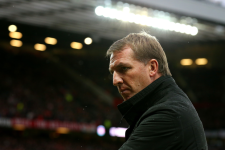

Now in his fourth season in charge of Liverpool, Brendan Rodgers is still without a trophy to his name.
The £29 million signing of Brazil striker Roberto Firmino is a clear statement of intent from the Northern Irishman, whose legacy will be judged on the silverware he is able to bring to the club.
Firmino’s transfer fee, young age and the hype surrounding his arrival are evocative of the infamous Andy Carroll signing, just under five years ago.
That was a move sanctioned by Kenny Dalglish – Rodgers’ predecessor – and it came to represent both the promise and failure of his second tenure as Liverpool manager. Dalglish may have coached the club to a League Cup triumph and FA Cup Final, but the project ultimately collapsed, with Carroll struggling for fitness and form.
Until this point Rodgers has typically avoided these sorts of transfers, happy to work within the parameters set by chairman Tom Werner and the Fenway Sports Group.
Given the importance of the role of the Carroll transfer in Dalglish’s exit from Liverpool, you get the sense that Firminio’s arrival will also be a defining moment for Rodgers.
Of all of the Liverpool arrivals this summer, the Brazilian is clearly under the most pressure: not only to perform, but also to force his way into a first-team in a top-heavy squad.
Did the shadow of the big-money move to England occupy the striker’s mind during the recent Copa America? He and his Brazilian teammates struggled and Rodgers would have been hoping for more encouraging displays.
The issue for Firmino is that he is in a unique situation within this squad and will begin to feel ostracized if he struggles to adapt quickly. Danny Ings, James Milner and Nathaniel Clyne have also been signed but the English trio are expected to perform different roles this season.
Liverpool need a talisman in the wake of Luis Suarez’s departure and Mario Balotelli’s failure to flourish within any of Rodgers’ systems. Firmino will need to be that man, as well as shoulder the goal-scoring burden, despite not arriving with an imposing goal-scoring record.
None of his fellow arrivals seem set to compliment the player on the pitch but Adam Lallana, Daniel Sturridge and Philippe Coutinho – all Rodgers signings – still remain at the club and are cultured footballers who might work well with the newcomer.
The likely sale of Raheem Sterling this summer (Liverpool and Man City have reportedly agreed a transfer fee of 49 million British Pounds) takes on a fascinating complexion: if it is confirmed, Rodgers might get the opportunity to re-invest those funds and perhaps assemble a supporting cast for Firmino.
Other high-profile arrivals would not only take some of the spotlight away from the Brazilian but also add quality and variety to a squad lacking in depth when compared Arsenal, Manchester City, Chelsea and Manchester United.
It would also do the same for Ings, Clyne and Milner, who would form part of the base of the squad, allowed to contribute to in a more rudimentary and consistent fashion. That is not to suggest they are limited players but rather than they are players who will be at their best when allowed to focus on their particular strengths.
Ultimately, Rodgers will also need to strike a balance between quality and quantity. Having already made a clutch of signings, the temptation could be to continue on in the same vein, but Benitez, Hodgson and Dalglish struggled to bring consistency and results after signing a larger pool of players.
Sterling’s likely departure and the arrival of replacements mean Rodgers is likely to go down a similar path this season, where a positive start – particularly in the league – will be crucial.
Written by Chris Paraskevas
Follow Chris on Twitter @Cparaskevas
Like O-Posts on Facebook
You can also follow O-Posts on Twitter @OPosts
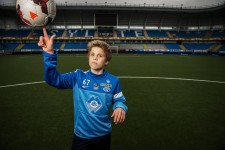
At 14, Tobias Svendsen had to get permission by the Norwegian FA to appear in a third tier game for Molde’s reserve team. Just a year later, he got his debut for the reigning champions in the cup.
The now 15-year-old midfielder is living in the shadow of his 17-year-old brother Sander Svendsen who has established himself in the first team, but Tobias is following not far behind.
QUICK FACTS:
Name: Tobias Svendsen
Date of birth: 31.08.2024 – Age: 15
Position: Midfielder
Club: Molde FK
Key strengths
His low centre of gravity, exquisite first touch, great understanding of the game and quick feet perfectly fits the bill for a modern central midfielder. He is very capable in small spaces, extremely difficult to get the ball off and is considered to be an aggressive midfielder with decent tackling abilities in defensive positions.
Molde manager Tor Ole Skullerud has on multiple occasions praised Tobias but he is keen to point out that they will not rush his development, especially as he is so young and has more physical growth to do.
“He has all the attributes to become a first team regular here at Molde. He is far ahead of his age in every way. It is still impossible to predict how far he will reach. Tobias has great potential but first he must get peace and quiet to develop,” Skullerud said to Norwegian press.
Stats
After Svendsen appeared in the 4-2 win against Rosenborg 2 at the third tier of Norwegian football over a year ago, he got a few appearances during the first team’s pre-season last winter. Then back in April 2015 he was handed his debut for the first team in the first round of the cup, a match Molde in the end won 2-0.
Considered an exceptional talent Svendsen was scouted at the age of 11 by Ajax. In fact, it was the younger of the Svendsen brothers that got the pair on the Dutch club’s radar when he was just 11, which two years later lead to his first of many trips to Amsterdam to train with the club.
For the time being Tobias is only thinking about becoming a better footballer, despite interest from Ajax. Claiming he is ‘too young’ to go professional abroad, Tobias told Norwegian press that it would be difficult to turn down an offer from Ajax ‘in a couple of years’.
“I have been abroad and seen how professional everything is, so yes, it is really tempting. I am too young to do that now, but of course it is a dream. If I receive an offer when I am 17 I would probably accept,” he said.
Written by Lars H. Thomesen
Follow Lars on Twitter @LarsHT
Like O-Posts on Facebook
You can also follow O-Posts on Twitter @OPosts